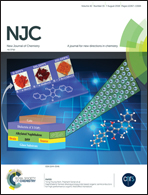A novel 3-hydroxychromone fluorescent probe for hydrogen sulfide based on an excited-state intramolecular proton transfer mechanism†
Abstract
Hydrogen sulfide (H2S) is a signaling gasotransmitter that plays important roles in modulating the functions of different systems. We have designed and synthesized a 3-hydroxychromone-based fluorescent probe A for H2S detection. Probe A is based on a H2S-induced thiolysis reaction and an excited-state intramolecular proton transfer (ESIPT) process. The probe shows high selectivity and sensitivity for the detection of H2S over glutathione, cysteine and homocysteine. Moreover, this probe was successfully applied for imaging exogenous and endogenous H2S in living cells.



 Please wait while we load your content...
Please wait while we load your content...